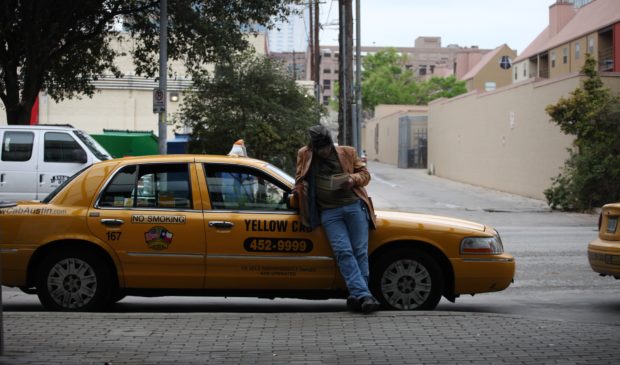Newsletter Signup
The Austin Monitor thanks its sponsors. Become one.
Most Popular Stories
- Austin opens new affordable housing development in Southeast Austin
- Congress Avenue transformation plan gets support from Urban Transportation Commission
- ZAP Commission forwards recommendation allowing some commercial uses in residential zones
- Ryan Alter and colleagues propose revision of boards and commissions
- Landmark commission says goodbye to Nau’s Enfield Drug
-
Discover News By District

In bid to save taxicabs, city proposes remaking them in rivals’ image
Thursday, February 15, 2018 by Caleb Pritchard
The Austin Transportation Department has gone public with a set of proposals aimed at saving the local taxicab industry by radically transforming it.
Acting Mobility Services Division Manager Jacob Culberson told the Urban Transportation Commission on Tuesday evening that ride-hailing transportation network companies such as Uber and Lyft are existential threats to the conventional taxi companies.
In October of 2014, the first year that the two Silicon Valley giants turned on their apps in Austin, local taxis provided 418,000 rides. A year later, that number dropped to 300,000 rides. In October 2016, after Uber and Lyft left town following a resounding rejection of regulations they put before voters, taxis served 563,000 trips. But the companies returned last year thanks to intervention from the Texas Legislature, and by October, taxi service had plunged 76 percent compared to the year before, to just 137,000 rides.
“ATD believes that if measures are not taken that allow taxicabs to compete on a level playing field with other ground transportation services not regulated by the city of Austin, taxicab operations will continue to decline until there are no more taxis operating in the city,” Culberson said before pointing to Waco as an example where this dire warning has turned into a reality.
To stave off that apocalyptic scenario, ATD is proposing a dramatic reform in taxi regulations. Currently, the city allows no more than five permitted franchises to operate. He explained that, due to the moribund state of the industry, only four companies – Yellow Cab, Austin Cab Company, Lone Star Cab, and ATX Co-op Taxi – currently operate in Austin. Those franchises face stiff regulations that Uber and Lyft and their drivers who work as independent contractors are allowed to skirt.
Culberson said that many of those regulations are outdated, including the requirements that franchises keep a brick-and-mortar headquarters within city limits and that drivers communicate with their dispatchers via two-way radio.
To allow taxi drivers the flexibility to compete with the far more nimble ride-hailing services, Culberson’s team is proposing a new regulatory framework that would allow taxicabs to set up under operating authorities rather than franchises. As proposed, companies set up under the new permitting structure would be able to adjust their fleet size on a quarterly basis, ratchet fares up or down in response to real-time demand, eschew identifying paint jobs and top lights, utilize virtual meters, set up headquarters outside of city limits, and ditch their two-way radios. Any number of companies could obtain an operating authority permit so long as each one has a minimum fleet of 25 cars.
“To be clear, the creation of a taxicab operating authority would not change the current taxicab franchises in any way. It would simply create a new category of ordinances permitting another form of taxicab service to begin operations,” Culberson said.
Despite that, John Bouloubasis, president of Texas Taxi, the parent company of Austin’s Yellow Cab franchise, expressed concerns about the proposed changes. He worried that allowing more drivers to operate outside of the franchise rules would reduce mobility options in Austin.
“Part of the franchise agreement states that they have to provide citywide service. Well, these little (operating authority) agreements don’t have citywide service. It eliminates that. It allows (drivers) to go sit at the airport or cab stands,” he said. “You need to pick up the elderly, the low-income, you need to stretch out across the city, not just post up the airport. So that’s the big elephant in the room.”
Hassan Aruri, an ATX Co-op Taxi board member, said that dramatic changes along the lines of the city’s proposals are needed. The current fees and regulations under the franchise agreements, he said, give an unbeatable competitive edge to TNCs and their drivers.
“Some people say that we’re becoming like cassette tapes, that we’re going to be obsolete. We don’t want to be obsolete. It’s not to our benefit,” he said. “We refuse to be cassettes.”
ATD staff members will continue to modify their draft recommendations based on further rounds of stakeholder input. Spokesperson Jen Samp told the Austin Monitor that they’ll bring a revised draft back to the UTC in the spring before delivering the final draft to City Council shortly thereafter.
As for the long-term need of any taxicab regulatory reform even as ATD is concurrently preparing for a future of shared electric and autonomous vehicles via the Smart Mobility Roadmap, Culberson told the Monitor, “Autonomous vehicles? We believe they are coming to the city of Austin. But when that is, we’re not so sure. We have hopes for the AV intrusion, but in the meantime, we have the taxi industry that needs help and has to have the ability to use modern technologies.”
Photo by Tom Woodward made available through a Creative Commons license.
The Austin Monitor’s work is made possible by donations from the community. Though our reporting covers donors from time to time, we are careful to keep business and editorial efforts separate while maintaining transparency. A complete list of donors is available here, and our code of ethics is explained here.
You're a community leader
And we’re honored you look to us for serious, in-depth news. You know a strong community needs local and dedicated watchdog reporting. We’re here for you and that won’t change. Now will you take the powerful next step and support our nonprofit news organization?








